engine coolant CHEVROLET PRIZM 1998 3.G User Guide
[x] Cancel search | Manufacturer: CHEVROLET, Model Year: 1998, Model line: PRIZM, Model: CHEVROLET PRIZM 1998 3.GPages: 364, PDF Size: 18.79 MB
Page 235 of 364

Downloaded from www.Manualslib.com manuals search engine Checking Things Under the Hood
/d CAUTION:
I
An electric fan under the hood can start up and
injure you even when the engine is not running.
Keep hands, clothing and tools
away from any
underhood electric fan.
I
A CAI v: I
I-
-
Things that burn can get on hot engine parts and
start
a fire. These include liquids like gasoline,
' oil, coolant, brake fluid, windshield washer and
other fluids, and plastic or rubber. You or others
could be burned. Be careful not to drop or spill
things that will burn onto a hot engine.
6-9
Page 237 of 364
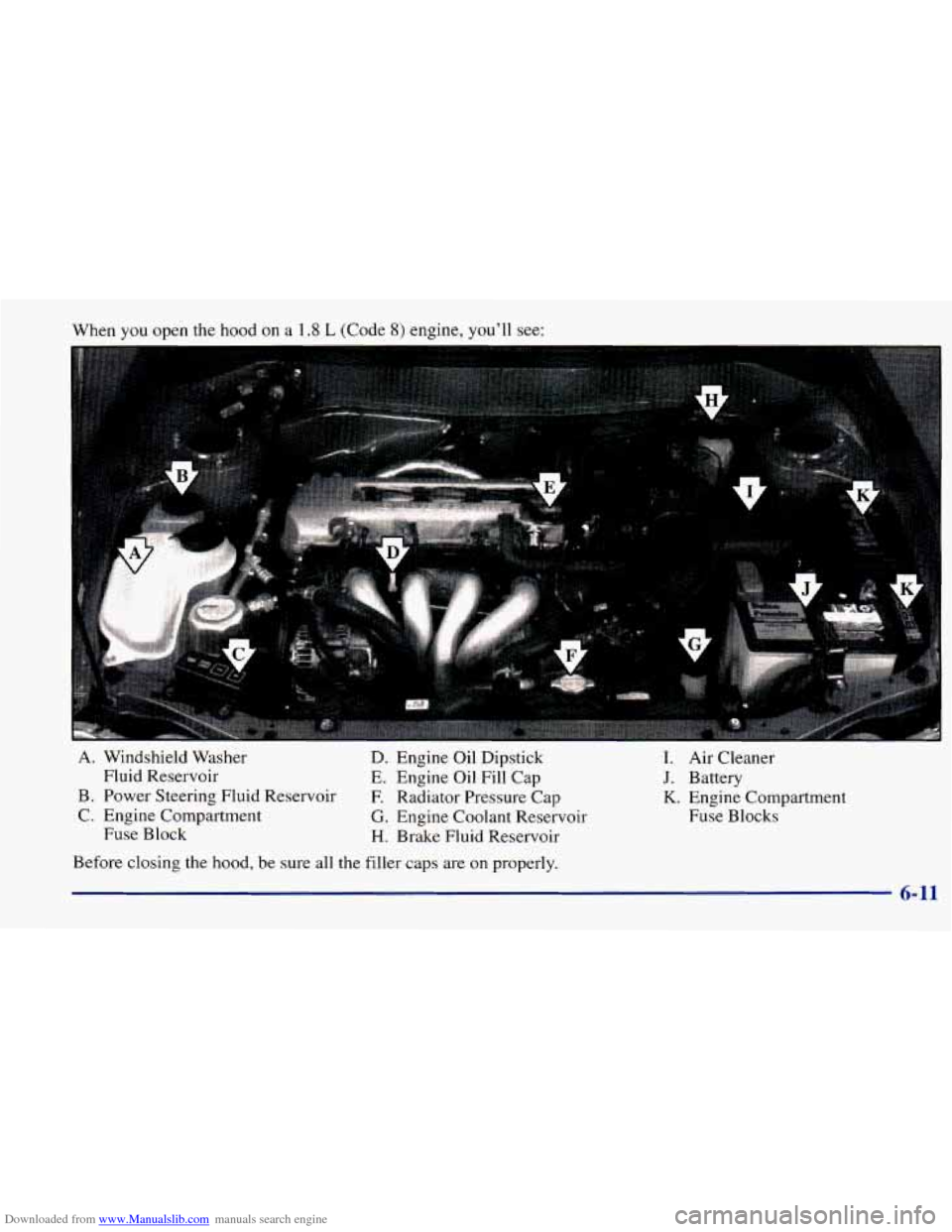
Downloaded from www.Manualslib.com manuals search engine When you open the hood on a 1.8 L (Code 8) engine, you'll see:
A. Windshield Washer
D. Engine Oil Dipstick I. Air Cleaner
Fluid Reservoir
E. Engine Oil Fill Cap
J. Battery
B. Power Steering Fluid Reservoir
F. Radiator Pressure Cap K. Engine Compartment
C. Engine Compartment
G. Engine Coolant Reservoir Fuse Blocks
Fuse Block
H. Brake Fluid Reservoir
Before closing the hood, be sure all the filler caps are on properly.
6-11
Page 245 of 364
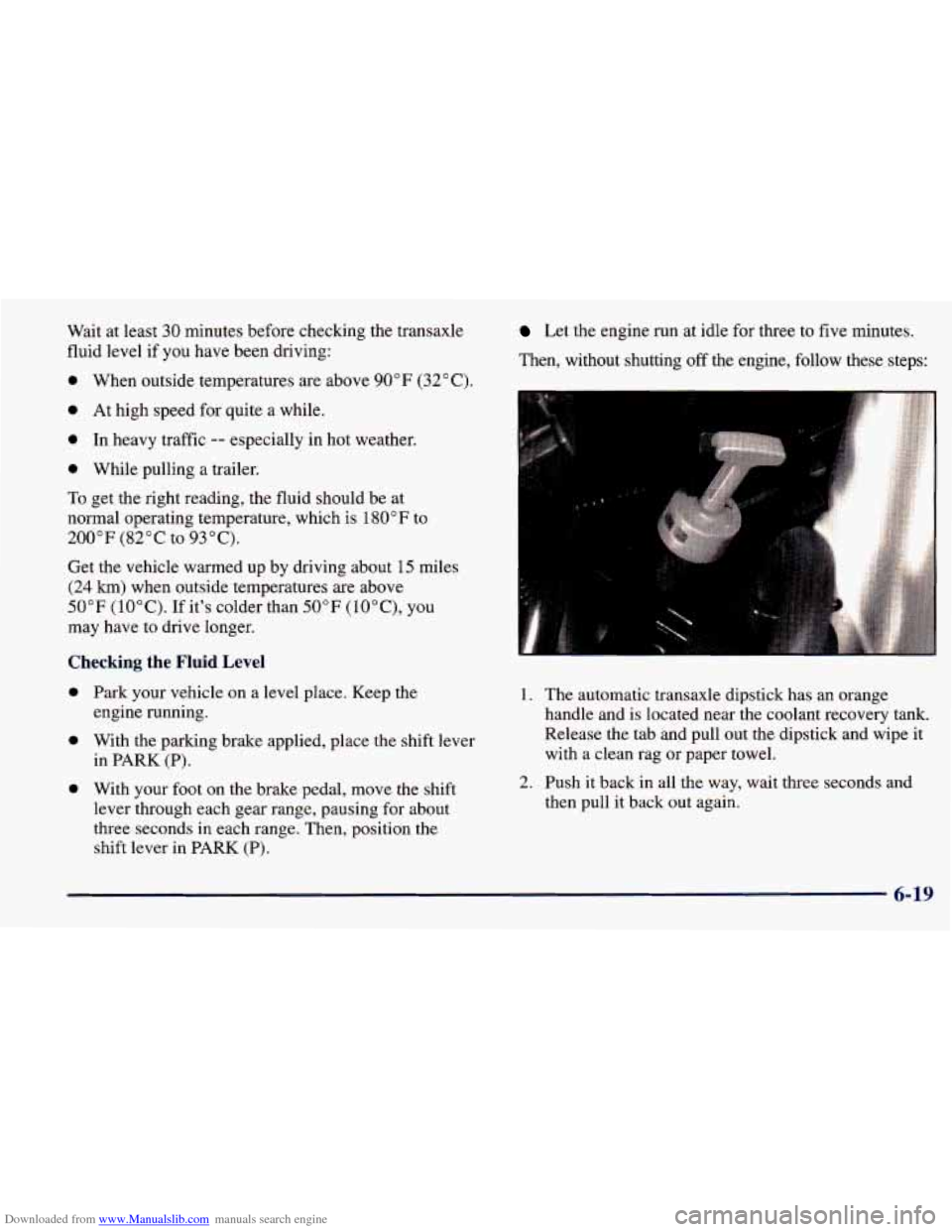
Downloaded from www.Manualslib.com manuals search engine Wait at least 30 minutes before checking the transaxle
fluid level if you have been driving:
0 When outside temperatures are above 90°F (32°C).
0 At high speed for quite a while.
0 In heavy traffic -- especially in hot weather.
0 While pulling a trailer.
To get the right reading, the fluid should be at
normal operating temperature, which is
180°F to
200°F (82°C to 93°C).
Get the vehicle warmed up by driving about 15 miles
(24 km) when outside temperatures are above
50°F (10°C). If it's colder than 50°F ( 10°C), you
may have to drive longer.
Checking the Fluid Level
0 Park your vehicle on a level place. Keep the
0 With the parking brake applied, place the shift lever
0 With your foot on the brake pedal, move the shift
lever through each gear range, pausing for about
three seconds
in each range. Then, position the
shift lever
in PARK (P).
engine running.
in PARK (P)
.
Let the engine run at idle for three to five minutes.
Then, without shutting
off the engine, follow these steps:
1. The automatic transaxle dipstick has an orange
handle and
is located near the coolant recovery tank.
Release the tab and pull
out the dipstick and wipe it
with a clean rag or paper towel.
then pull it back out again.
2. Push it back in all the way, wait three seconds and
6-19
Page 249 of 364
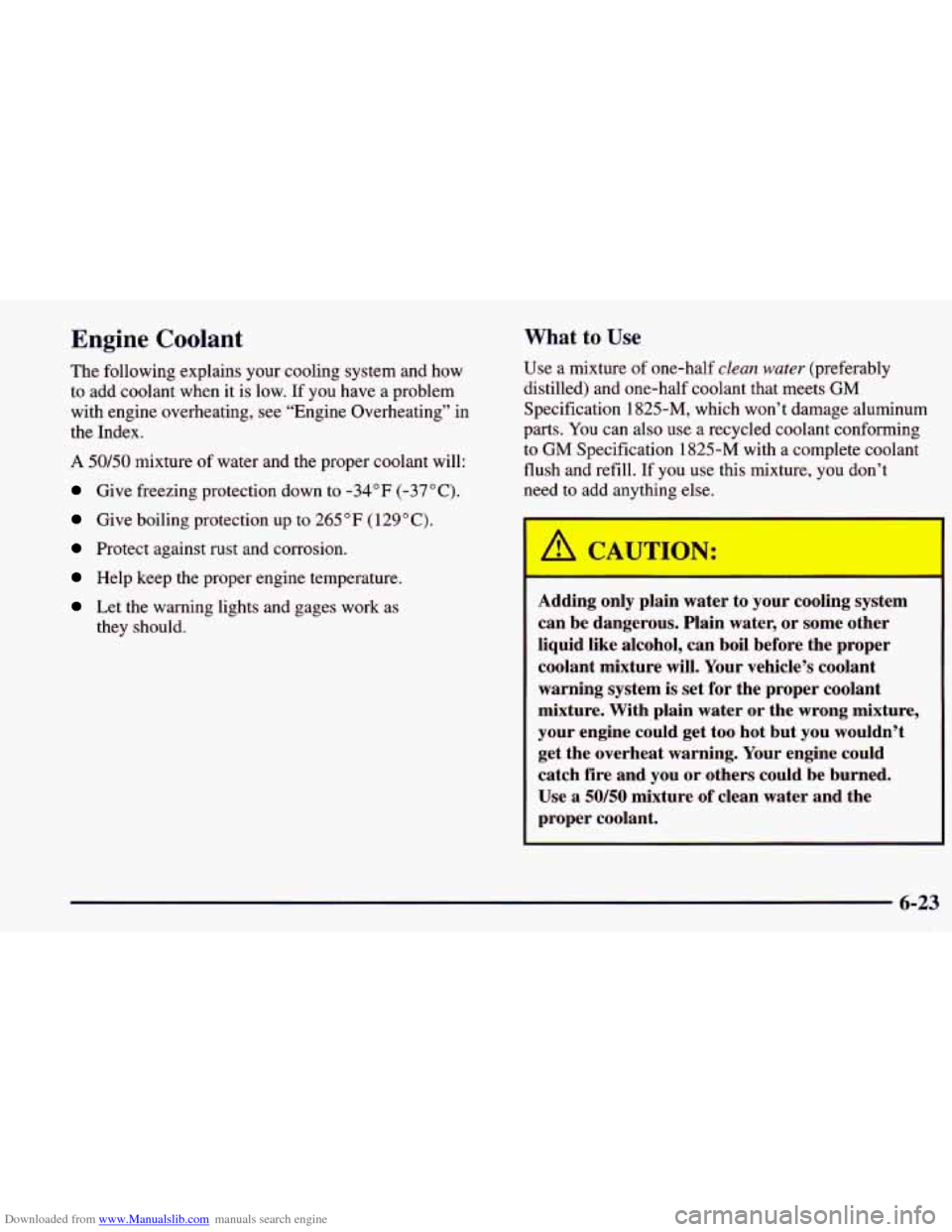
Downloaded from www.Manualslib.com manuals search engine Engine Coolant What to Use
The following explains your cooling system and how
to add coolant when it is low.
If you have a problem
with engine overheating, see “Engine Overheating” in
the Index.
A 50/50 mixture of water and the proper coolant will:
Give freezing protection down to -34°F (-37°C).
Give boiling protection up to 265°F (129°C).
Protect against rust and corrosion.
Help keep the proper engine temperature.
Let the warning lights and gages work as
they should. Use
a mixture of one-half
clean water (preferably
distilled) and one-half coolant that meets
GM
Specification 1825-M, which won’t damage aluminum
parts.
You can also use a recycled coolant conforming
to
GM Specification 1825-M with a complete coolant
flush and refill. If you use this mixture, you don’t
need to add anything else.
IC ION:
Adding only plain water to your cooling system
can be dangerous. Plain water, or some other
liquid like alcohol, can boil before the proper
coolant mixture will. Your vehicle’s coolant
warning system is set for the proper coolant
mixture.
With plain water or the wrong mixture,
your engine could get too hot but you wouldn’t
get the overheat warning. Your engine could
catch fire and you or others could be burned.
Use a
50/50 mixture of clean water and the
proper coolant.
6-23
Page 250 of 364
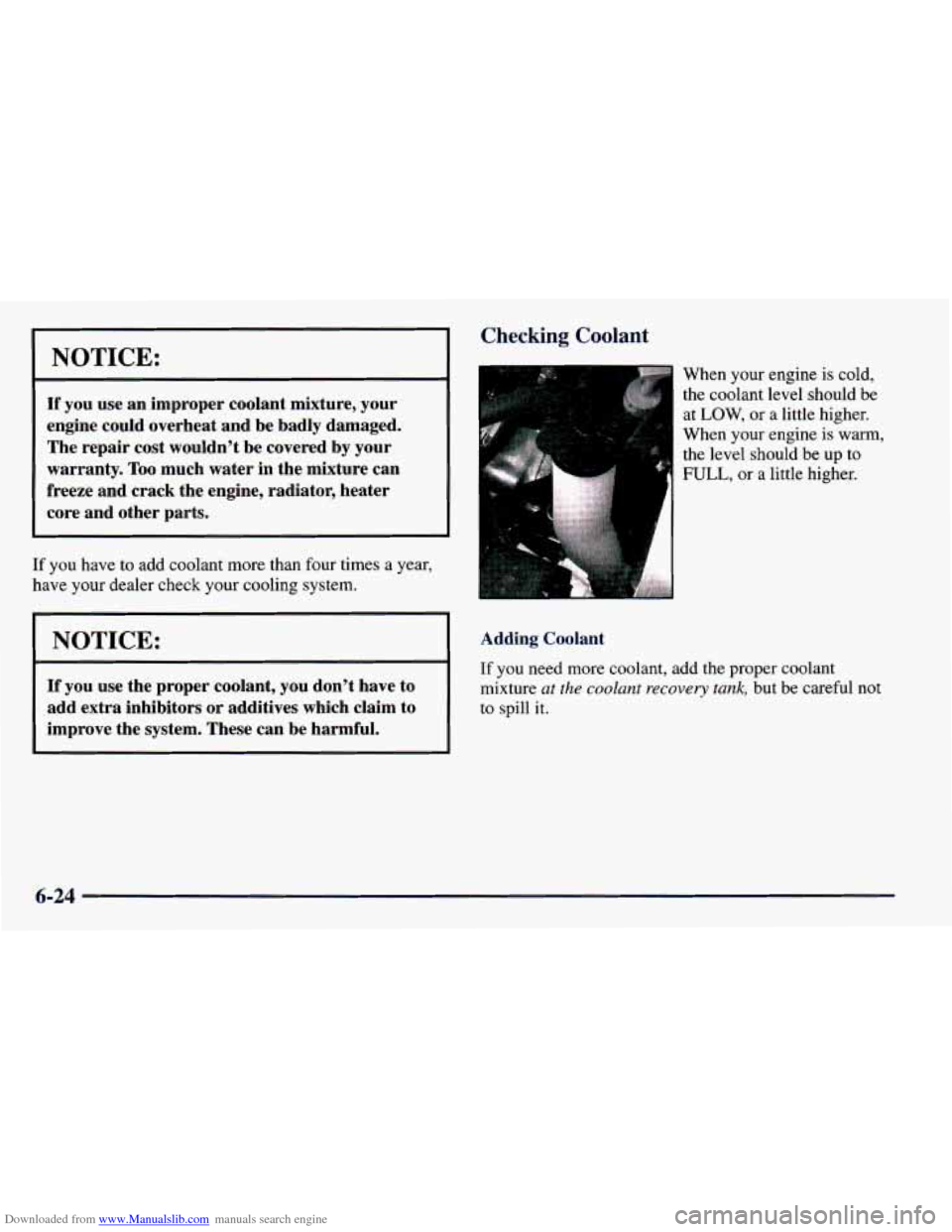
Downloaded from www.Manualslib.com manuals search engine NOTICE:
If you use an improper coolant mixture, your
engine could overheat and be badly damaged.
The repair cost wouldn’t be covered
by your
warranty. Too much water in the mixture can
freeze and crack the engine, radiator, heater
core and other parts.
If you have to add coolant more than four times a year,
lave
your dealer check your cooling system.
I NOTICE:
If you use the proper coolant, you don’t have to
add extra inhibitors or additives which claim to
improve the system. These can be harmful.
Checking Coolant
When your engine is cold,
the coolant level should be
at
LOW, or a little higher.
When your engine is warm,
the level should be up to
FULL, or a little higher.
Adding Coolant
If you need more coolant, add the proper coolant
mixture
at the coolant recovery tank, but be careful not
to spill it.
6-24
Page 251 of 364

Downloaded from www.Manualslib.com manuals search engine Radiator Pressure Cap
Wrning the radiator pressure cap when the
engine and radiator are hot can allow steam and
scalding liquids to blow out and burn you badly.
With the coolant recovery tank, you will almost
never have to add coolant
at the radiator.
Never turn the radiator pressure cap
-- even a
little -- when the engine and radiator are hot.
A CAUTION:
d if you spill coolant on hot
engine parts. Coolant contains ethylene glycol,
and it will burn if the engine parts are hot
enough. Don’t spill coolant on
a hot engine.
I NOTICE:
Your radiator cap is a 15 psi (105 kPa)
pressure-type cap and must be tightly installed to
prevent coolant loss and possible engine damage
from overheating. Be sure the arrows on the cap
line up with the overflow tube on the radiator
filler neck.
Thermostat
Engine coolant temperature is controlled by a thermostat
in the engine coolant system. The thermostat stops the
flow of coolant through the radiator until the coolant
reaches a preset temperature.
When you replace your thermostat, a General Motors@
thermostat is recommended.
6-25
Page 254 of 364
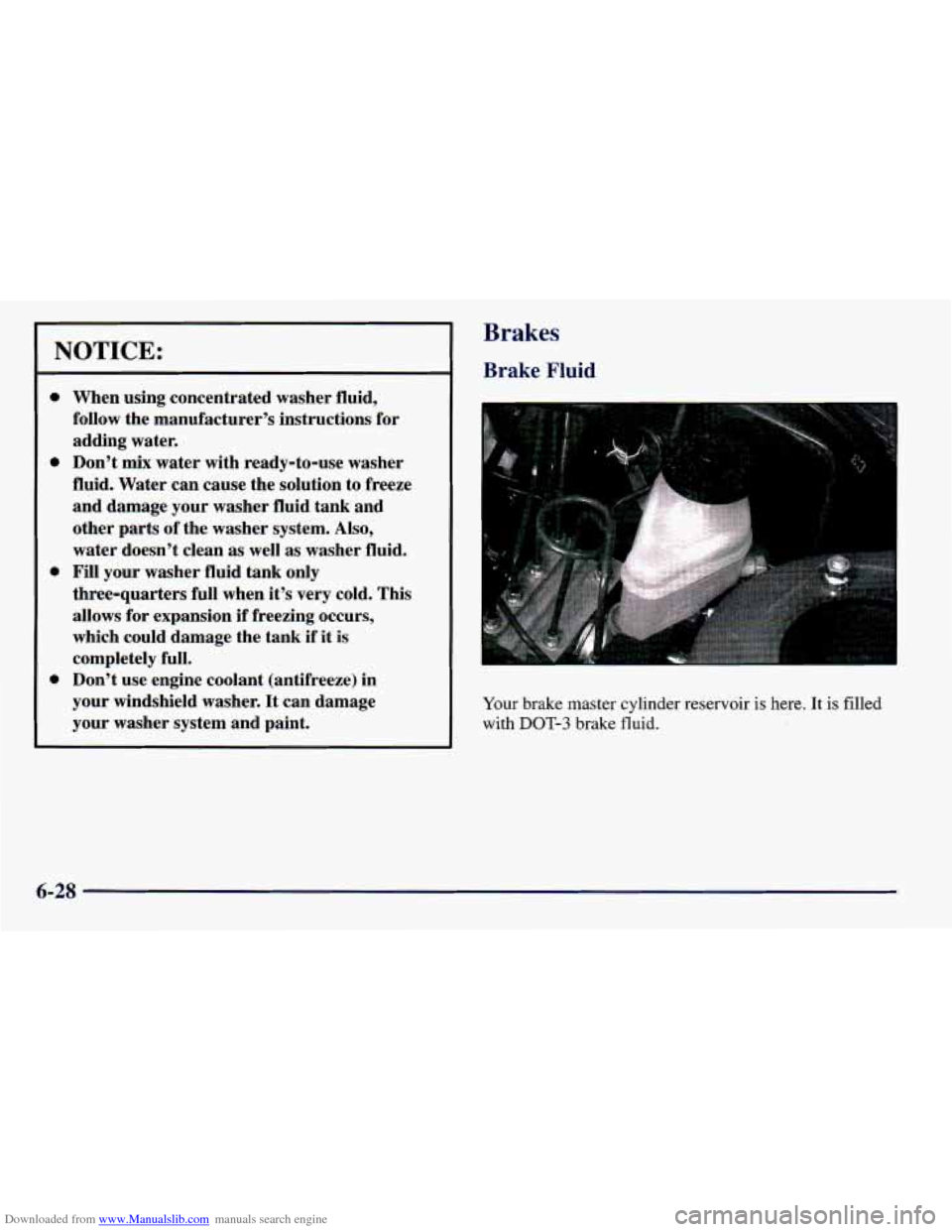
Downloaded from www.Manualslib.com manuals search engine NOTICE:
Brakes
Brake Fluid
0
0
0
0
When using concentrated washer fluid,
follow the manufacturer’s instructions for
adding water.
Don’t
mix water with ready-to-use washer
fluid. Water can cause the solution to freeze
and damage your washer fluid tank and
other parts of the washer system. Also,
water doesn’t clean as well
as washer fluid.
Fill your washer fluid tank only
three-quarters full when it’s very cold. This
allows for expansion if freezing occurs,
which could damage the tank
if it is
completely full.
Don’t use engine coolant (antifreeze) in
your windshield washer. It can damage
your washer system and paint.
Your brake master cylinder reservoir is here. It is filled
with DOT-3 brake fluid.
6-28
Page 299 of 364

Downloaded from www.Manualslib.com manuals search engine Short TripKity Maintenance Schedule
Rotate tires. See “Tire Inspection and Rotation” in the Index for proper
0 Drain, flush and refill cooling system (or every 24 months, whichever occurs
rotation pattern and additional information. (See
footnote
+.)
first). See “Engine Coolant” in the Index for what to use. Inspect hoses. Clean
radiator, condenser, pressure cap and neck. Pressure test cooling system and
pressure cap.
An Emission Control Sewice. (See footnote “f)
0 Change manual transaxle fluid every 30,000 miles (50 000 km) only if your
vehicle is used to tow a trailer.
0 Change automatic transaxle and differential fluid every 15,000 miles
(25 000 km) if the vehicle is mainly driven under one or more of
these conditions:
- In heavy city traffic where the outside temperature regularly reaches
- In hilly or mountainous terrain.
- When doing frequent trailer towing.
- Uses such as found in taxi, police or delivery service.
90°F (32°C) or higher.
If you do not use your vehicle under any of these conditions, check the fluid.
7-13
Page 304 of 364
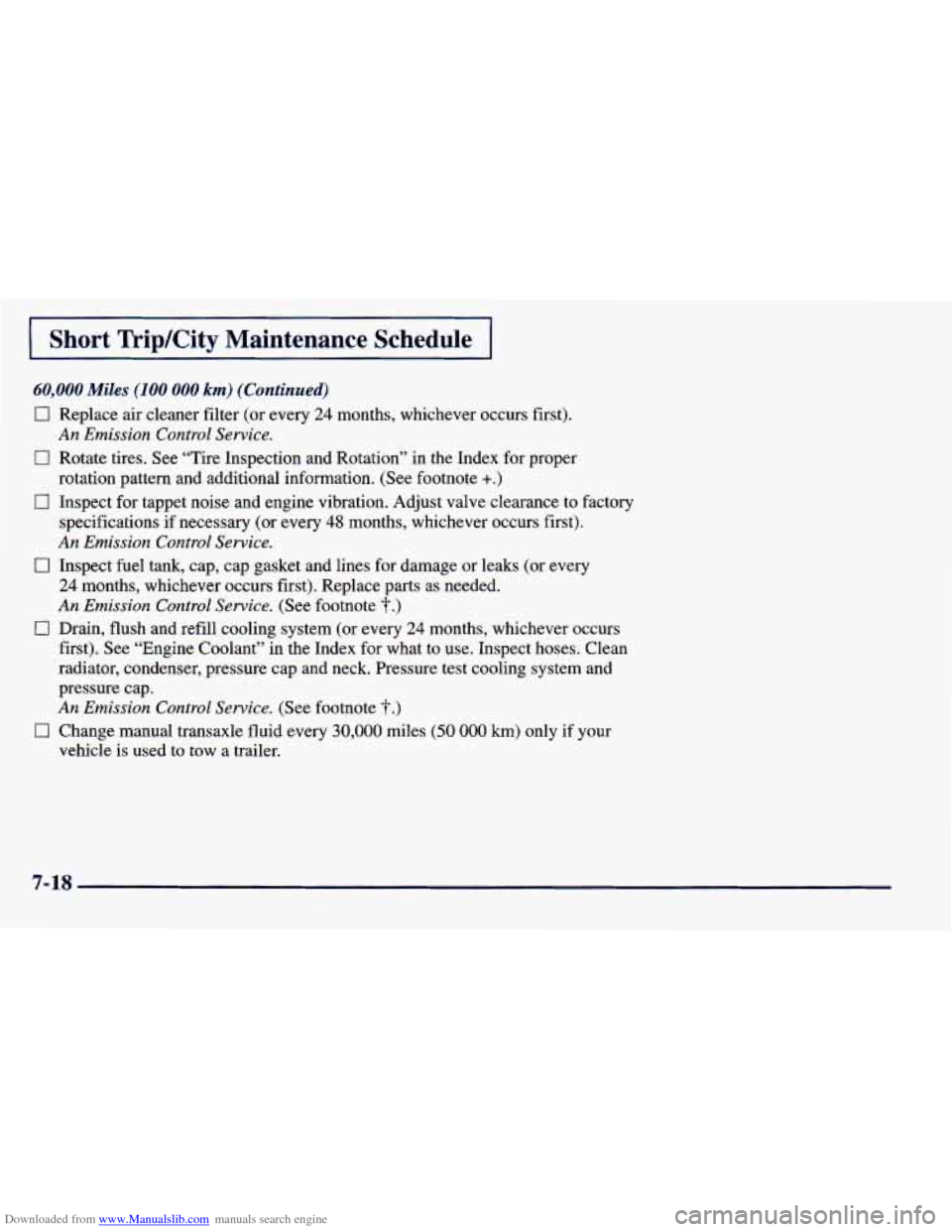
Downloaded from www.Manualslib.com manuals search engine I Short Trip/City Maintenancc 5chedule 1
60,000 Miles (100 000 km) (Continued)
0
0
0
0
0
0
Replace air cleaner filter (or every 24 months, whichever occurs first).
An Emission Control Service.
Rotate tires. See “Tire Inspection and Rotation” in the I\
ndex for proper
rotation pattern and additional information. (See footnote
+.)
Inspect for tappet noise and engine vibration. Adjust valve clearance to fa\
ctory
specifications if necessary (or every 48 months, whichever occurs first).
An Emission Control Service.
Inspect fuel tank, cap, cap gasket and lines for damage or leaks (or every
24 months, whichever occurs first). Replace parts as needed.
An Emission Control Service. (See footnote “f)
Drain, flush and refill cooling system (or every 24 months, w\
hichever occurs
first). See “Engine Coolant”
in the Index for what to use. Inspect hoses. Clean
radiator, condenser, pressure cap and neck. Pressure test coolin\
g system and pressure cap.
An Emission Control Service. (See footnote “f)
Change manual transaxle fluid every 30,000 miles (50 000 km) only if your
vehicle is used to tow a trailer.
7-18
Page 310 of 364
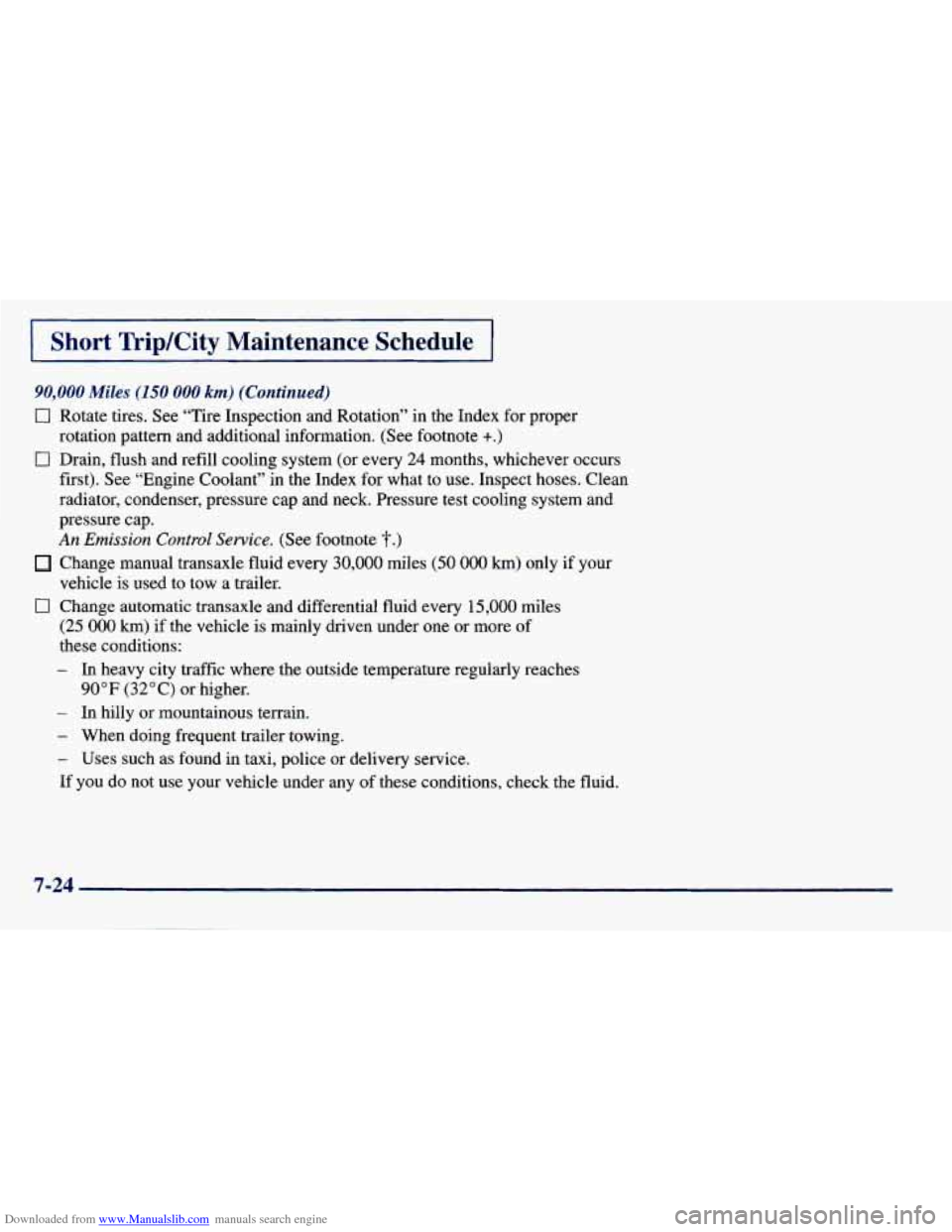
Downloaded from www.Manualslib.com manuals search engine I Short TripKity Maintenance Schedule I
90,000 Miles (150 000 km) (Continued)
0 Rotate tires. See “Tire Inspection and Rotation” in the Index for proper
0 Drain, flush and refill cooling system (or every 24 months, whichever occurs
rotation pattern and additional information. (See footnote
+.)
first). See
“Engine Coolant’’ in the Index for what to use. Inspec\
t hoses. Clean
radiator, condenser, pressure cap and neck. Pressure test cooling system and
pressure cap.
An Emission Control Sewice. (See footnote “f)
Change manual transaxle fluid every 30,000 miles (50 000 km) only if your
vehicle
is used to tow a trailer.
0 Change automatic transaxle and differential fluid every 15,000 miles
(25 000 km) if the vehicle is mainly driven under one or more of
these conditions:
- In heavy city traffic where the outside temperature regularly reaches
90 OF (32 O C) or higher.
- In hilly or mountainous terrain.
- When doing frequent trailer towing.
- Uses such as found in taxi, police or delivery service.
If you do not use your vehicle under any of these conditions, check the \
fluid.
7-24